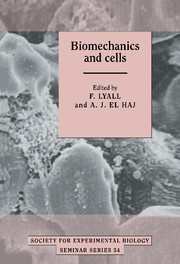Book contents
- Frontmatter
- Contents
- List of contributors
- PART 1 SOFT TISSUE
- Signal transduction pathways in vascular cells exposed to cyclic strain
- Effects of pressure overload on vascular smooth muscle cells
- Effect of increased flow on release of vasoactive substances from vascular endothelial cells
- Modulation of endothelium-derived relaxing factor activity by flow
- Stretch, overload and gene expression in muscle
- Stretch sensitivity in stretch receptor neurones
- Mechanical interactions with plant cells: a selective overview
- Mechanical tensing of cells and chromosome arrangement
- Alterations in gene expression induced by low-frequency, low-intensity electromagnetic fields
- PART 2 HARD TISSUE
- Index
Mechanical tensing of cells and chromosome arrangement
Published online by Cambridge University Press: 19 January 2010
- Frontmatter
- Contents
- List of contributors
- PART 1 SOFT TISSUE
- Signal transduction pathways in vascular cells exposed to cyclic strain
- Effects of pressure overload on vascular smooth muscle cells
- Effect of increased flow on release of vasoactive substances from vascular endothelial cells
- Modulation of endothelium-derived relaxing factor activity by flow
- Stretch, overload and gene expression in muscle
- Stretch sensitivity in stretch receptor neurones
- Mechanical interactions with plant cells: a selective overview
- Mechanical tensing of cells and chromosome arrangement
- Alterations in gene expression induced by low-frequency, low-intensity electromagnetic fields
- PART 2 HARD TISSUE
- Index
Summary
Many reports have been made describing how the application of mechanical forces to cells leads to changes in gene expression. Several of the contributions to this volume report on that matter. In addition it is pertinent to quote papers by Goldspink and his colleagues (see, for example, Goldspink et al., 1992). The next question that arises is: how do such force applications lead to changes in gene expression?
Amongst the various theories that have been proposed to explain these effects on gene expression are the following.
That mechanical tension opens specific or non-specific ion channels that lead to changes in the cell, either operating through signalling systems or simply facilitating the entry of nutritive factors into the cell. Since stretch receptors are well known in neurones (e.g. Blackshaw & Thompson, 1988; Sigurdson & Morris, 1989) this theory has direct experimental support as a possible mechanism, although the activation of stretch reception does not in itself lead to transcriptional changes.
That mechanical tension affects the cytoskeleton and that this in turn operates either translationally in the cytoplasm or on nuclear events to alter expression (Pender & McCulloch, 1991).
That mechanical tension activates signalling processes at the plasma membrane (Horoyan et al., 1991). This suggestion is explored by several other contributors to this volume, see for example the chapter by D. Jones.
That all that mechanical tension does, whether acting directly on the cells or more indirectly, is to provide more stirring of the medium around the cells or better access of metabolites to the cells and better removal of waste products. Dunn & Ireland (1984) suggested that this accounted for the effects of mechanical tension on cell growth in fibroblasts.
- Type
- Chapter
- Information
- Biomechanics and Cells , pp. 121 - 130Publisher: Cambridge University PressPrint publication year: 1994
- 8
- Cited by



